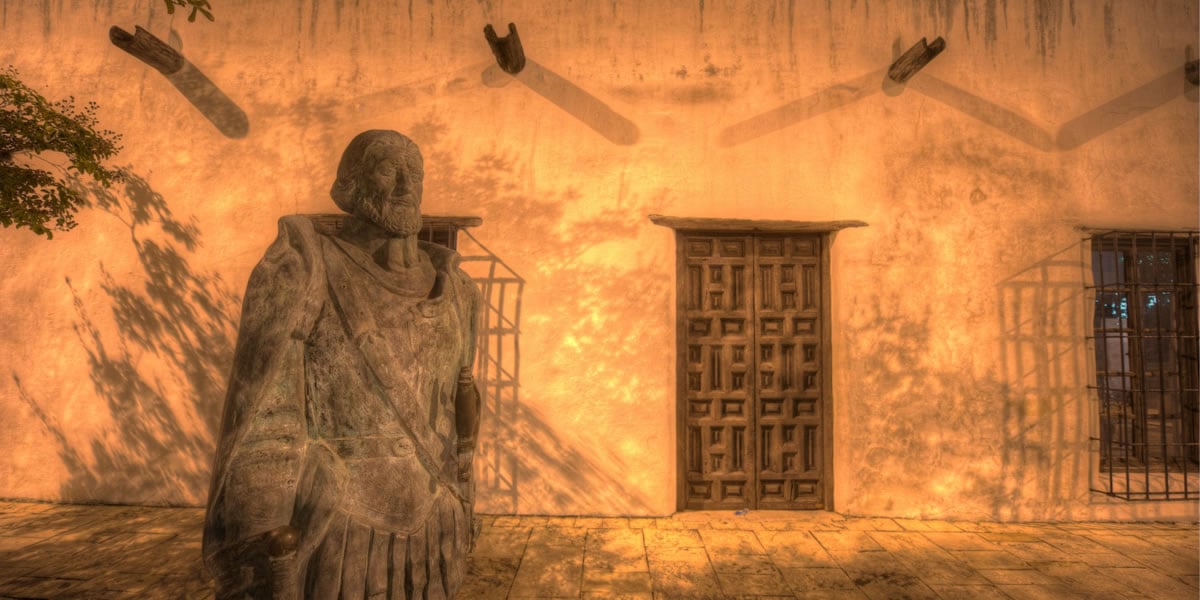
Above the hard-carved, walnut entry doors of the Spanish Governor's Palace is an escudo (coat of arms) which bears the emblem of the Hapsburg crest of the Double Eagle. The eagles sit back to back, a single spine shared between them, with an elaborate crown positioned over their heads. The crest was once the marker of King Philip V of Spain, who commissioned the construction of the building.
Or so that inscription etched into the crest reads: uno 1749, se acabo. “It finished in the year 1749."
The Spanish Governor’s Palace wasn’t finished in that year, nor was the property intended to be the home of the Spanish governor of Texas when it was built. But that lore is all part of the history of the Spanish Governor’s Palace.
Well that, and also the fact ghosts are said to haunt the eighteenth-century walls of the Spanish Governor’s Palace.
The French and the Spanish were never too fond of each other in colonial America.
Spanish Florida saw the massacre of French Lutherans by the Spanish army in 1565. Much later, in the 1750s, the French turned to the Spanish for aid in the French and Indian War in a moment of desperation. The Spanish refused until later, in 1762, when the French offered to give up their Louisiana colony as an incentive for the Spanish to step in. (We won’t even talk about the Middle Ages when the two neighboring countries were always at each other’s throats).
And, in 1718, when our particular story unfolds, King Philip V of Spain worried about burgeoning tensions between France and Spain in Southwestern North America. The French in early Louisiana were slowly spreading west toward San Antonio in Texas. Philip V would have none of it. To protect the Crown’s land, King Philip V ordered the governor of Coahuila and Texas, Don Martin de Alarcon, to build a mission and presidio (a fortified settlement) where the San Antonio River and San Pedro Creek meet.
On May 5, 1718, Don Martin de Alarcon followed the Crown’s stringent orders and founded the Presidio San Antonio de Bejar in order to protect the newly erected Mission San Antonio de Valero (a.k.a. the Alamo). By 1722, the Marques de Aguayo had moved the fortified presidio away from its original position a half mile down the river, to just across the San Antonio River from the Alamo itself.
The Marques had big plans for the presidio. Grand, actually. He dreamed of a large, square-shaped fortification with sharp bastions to ward off the enemy. To make it happen, the Marques needed quality materials. Naturally he wrote to the King of Spain asking for 25,000 adobe bricks to be sent over from the motherland. And then, because the bricks were obviously not enough, the Marques also asked forty more laborers so that construction on the presidio could begin.
It seems that the Crown agreed, because not long after the necessary items were shipped (literally, y’all) over from Spain that building began.
Although the keystone above the entrance doors claim construction didn’t finish until 1749, it’s believed that completion of the fortification had come some time earlier. The comandancia, as it was known, functioned as the office and residence for the captain of the entire presidio. By the 1760s, the presidio was in charge of the defense for five of the local missions, as well as the villa of San Fernando de Bejar. It also supplied guards for the missionaries and other important dignitaries.
In truth, the comandancia and the encompassing presidio were the stronghold for the entire area.
The capital of Spanish Texas moved from Los Adaes, east of Nacogdoches, to San Antonio in 1773. Though the Spanish Governors stayed in East Texas for the most part, the comandancia became home to a long string of Spanish captains.
While the presidio had once acted as a line of defense to the budding villa, after 1773, it became a place where justice was served. In the courtyard behind the main building, approximately thirty-five people were hanged for their crimes. The site was one of bloodshed and battle, where the captains protected the villa against raiding Native American tribes.
The presidio might have been the seat of the Texas government, but it is said that at least one gritty murder took place on the land.
The last captain to live at the presidio was Jose Menchaca and he sold the whole property to Ignacio Perez, a prominent merchant and landowner, in 1804. Perez paid a staggering 800 pesos for the property, which equaled to about $55,000 at that time. (Probably over a million dollars today). Perez’s family continued to own the property until the 1860s, throughout the fight for Texas Independence, when the presidio ended its military fortification streak in 1836 after Texas became an independent state.
Post- Civil War San Antonio was a strange city to behold. Ranchers and farmhands who had once lived in the city centre, working the pastures near the Alamo or the presidio, soon chose to move out to the suburbs. These neighborhoods were growing, filling with people. Meanwhile, many of the old abandoned buildings in the villa were becoming homes to a host of different businesses.
After the 1860s, the Ignacio Perez’s descendants began to lease the old presidio out. One of the first to acquire the property was E. Hermann Altgelt, who happened to be the founder of the village of Comfort, Texas. He lived at the presidio with his wife, Emma. Even after Altgelt passed, his widow continued to make the old fortification home until the early 1900s.
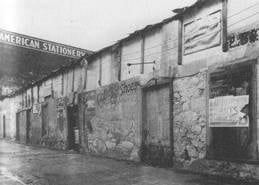
By then, the property had fallen into disrepair.
Different business utilized the presidio’s various rooms for commercial purposes. It began as a tavern that sold nickel beer, a produce market, a tailor shop, a pawn shop, a school and a clothier.
(Not particularly in this order).
It was during this period that rumors of ghosts at the presidio began to spread. Maybe it was the appearance of an ancient building falling apart, losing its pride and beauty, that ignited the rumors about town.
Maybe, except that the presidio then underwent a major restoration period . . . and talk of ghosts stilled continued thereafter.
It was all in thanks to Adina Emilia De Zavala (1861-1955) that the presidio ever returned to its former glory.
De Zavala was one of Texas’ first preservationists. In a newspaper article dated to 1915, she pointed out that “the old stone building across the street from City Hall was more than just a decrepit eyesore—it was, in fact, the remains of one of the oldest and most important structures in the state.” How important, you might ask? So important that she then began to call the presidio the Spanish Governor’s Palace, even though the building was certainly not palatial and it had also never been home to one of the Spanish governors.
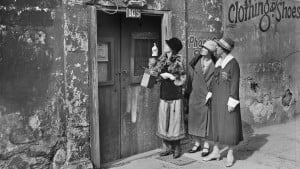
Even so, she spent all of her energy in pushing the need to restore the property. For fifteen years, Adina Emilia De Zavala fought against those who wished to demolish the presidio.
De Zavala’s efforts won out, because in 1928 the city of San Antonio acquired the Spanish Governor’s Palace and a movement to restore a piece of the city’s history and heritage commenced.
Project plans fell to architect Harvey P. Smith to put into action, and, over the next three years, Smith did his best to maintain as much of the original structure as he could. Old photographs, archaeological excavations and research proved vital to the restoration of the Spanish Governor’s Palace.
They spent nearly $29,500 on all of the restoration, but by the end, the property was revitalized. Even most of the furniture inside dates to the late eighteenth-century, including a hard-carved desk in the front bedchamber that once belonged to the James Bowie! (One of the Alamo’s defenders who died for the cause of Texas Independence).
Since 1931, the Spanish Governor’s Palace has functioned as a Museum of Spanish Colonial History. It was listed as a Texas Historic Landmark in 1962, and less than ten years later in 1970, it was named a National Historic Landmark, too.
Today, it is operated by the San Antonio Parks & Recreation, and is one of the most visited museums in all of San Antonio. A “living history” group, La Romania de Cavallaria del Real Presidio de San Antonio de Bejar, performs on the final Sunday of each month. Every performance varies from month to month, but all depict scenes from the time period in which the Spanish Governor’s Palace was first being used.
Although it has undergone major renovation, the U-shaped white-stucco structure that encircles the patio and courtyard is one of its only original features. Even so, the presidio has become the last remaining example of an aristocratic eighteenth-century Spanish townhouse in all of Texas.
But despite the fact that a large part of the property has been fixed, it remains one of the most beautiful places to visit in San Antonio.
And also one of its most haunted, as well.
Since the early 1900s when the Spanish Governor’s Palace’s eighteenth-century walls were home to a variety of businesses, reports of paranormal activity has been attached to the property.
Apparitions of Native American peoples standing by the outer walls have been spotted; but so, too, have the translucent figures of Spanish Colonials. Those who wander near or stand near the property itself often feel undeniable cold spots, so much so that the fine hairs on the back of their arms stand up tall and the sensation that you are not alone increases the rhythm of your breathing as fear takes hold.
Perhaps one of the most haunted parts of the Spanish Governor’s Palace is the old, original patio at the rear of the building.
They call it the “Tree of Sorrows.”
At the time when the presidio functioned also as San Antonio’s main quarters for justice—that was, until a new City Hall was built with an accompanying jail--the presidio was it.
Trial. Jury. Verdict.
The comandancia was an all-in-one go, where a criminal went to be judged, tried and punished. And it is at the alleged Tree of Sorrows where at least thirty-five of these criminals were hanged for their crimes.
Whether true or false, there are some who claim that the marks from the tightened rope can still be seen in the bark of the branches, where the friction rubbed so harshly as each person fell to their death that the wood has chipped away.
Visitors of the Spanish Governor’s Palace have seen these figures, as the saying goes, “dancing in the breeze” as if in the after-life their energy has remained here on the earthly plane to revisit the scene of their death over and over again.
Paranormal investigators who have explored the old presidio have even more evidence that these criminals have yet to move on to the Other Side. During the course of their overnight stay at the Spanish Governor’s Palace, they caught multiple orbs around the Tree of Sorrows. So many orbs, actually, that one investigator commented that tree looked completely lit up by all the spectral energy.
At the Tree of Sorrows, it’s no question as to who is still haunting the rear courtyard, but one has to wonder . . . What did those restless spirits do in life that they are unable to leave the site of their death now, over a century later?
According to local paranormal reports of phenomena occurring at the Spanish Governor’s Palace, there are a few ghostly children still haunting the old fortification.
The first spirit is a little girl who makes her presence known in one of the bedrooms at the comandancia. It’s uncertain who she is, but visitors of the museum have commented that they have felt incredibly cold upon entering the bedroom that the young girl is said to haunt. Even those unaware of the story remark that they feel as though they are being watched the entire time. For the most part, the young girl’s spirit stays quarantined to this room and she hasn’t been sensed elsewhere.
The ghost of another young girl has been spotted by the well in the courtyard. Legend has it that she was related to one of the prior governors who visited the presidio. But upon wandering into the courtyard, curiosity got the best of the little girl and she stepped too close to the well. Trailing her fingers along the brick, she gripped the sides and leaned over to peer down into the dark depths of the water-source.
It was too late.
Her little body wobbled on the precipice of the well, and gravity proved relentless. Down she went, falling to her death. Her body was soon recovered, and as strange as it is, her little body is said to have been interred in the wall surrounding the well itself.
Her spirit is said to still haunt the area, and people have reported seeing a young, dark-haired girl sitting on the wall of the well weeping. Is it possible that the apparition is of the little girl who mistakenly fell into the well . . . or is possible that the weeping girl seated on the wall is the ghost of a more gruesome death?
The dark blanket of the night had already fallen over the presidio and the City of San Antonio when they arrived under the covert of darkness.
Robbers, a group of them.
They’d planned their thievery well, waiting until the captain’s family had left the property on a trip. They barged through the doors, collecting every bit of valuable items that they could find along the way. Gold. Silver. They dropped the objects into their bags, scouring the comandancia for more goods.
Carefully, they moved to the courtyard at the rear of the building. Had they all targeted separate areas of the property? Had they moved as one unit? The minute details have been lost to history, to hearsay, to local lore, but upon entering the courtyard their greedy gazes glimpsed the figure of a girl.
In some stories, she was the governess of the Spanish captain’s children. In others, she was simply one of the servants of the presidio, left behind to watch over the priceless valuables.
Whoever the young girl was, the robbers caught sight of her and panicked at the chance of their identities being discovered. She was jerked to the ground, a length of harsh rope tied around her wrists and another around her ankles. Bound with no hope for escape, she was tossed over the side of the well to plummet the 37ft. down to her death.
She drowned in that well, on that dark night when robbers stole into the fortification to steal the treasures of the house. And her death would never have been uncovered if it weren’t for one of the robbers experiencing complete remorse about what he had done.
He came forward and spilled his dirty secret. (One has to wonder if he was punished at the hanging tree, as one of the criminals who met their end dancing in the breeze).
Today, the present day custodian of the Spanish Governor’s Palace has heard all sorts of sounds at the well in the courtyard. “Gurgling” and water bubbling up are just a few, and during the times that he has had to go down into the well to collect the coins tossed in by tourists, he has felt strangely and uneasy.
Is the young girl weeping at the well the servant or the daughter of one of the former captain’s? Though the answer eludes us, one thing is for certain: the ghosts roaming the area of the well have their own ghastly, gritty tales to tell of their gruesome deaths.
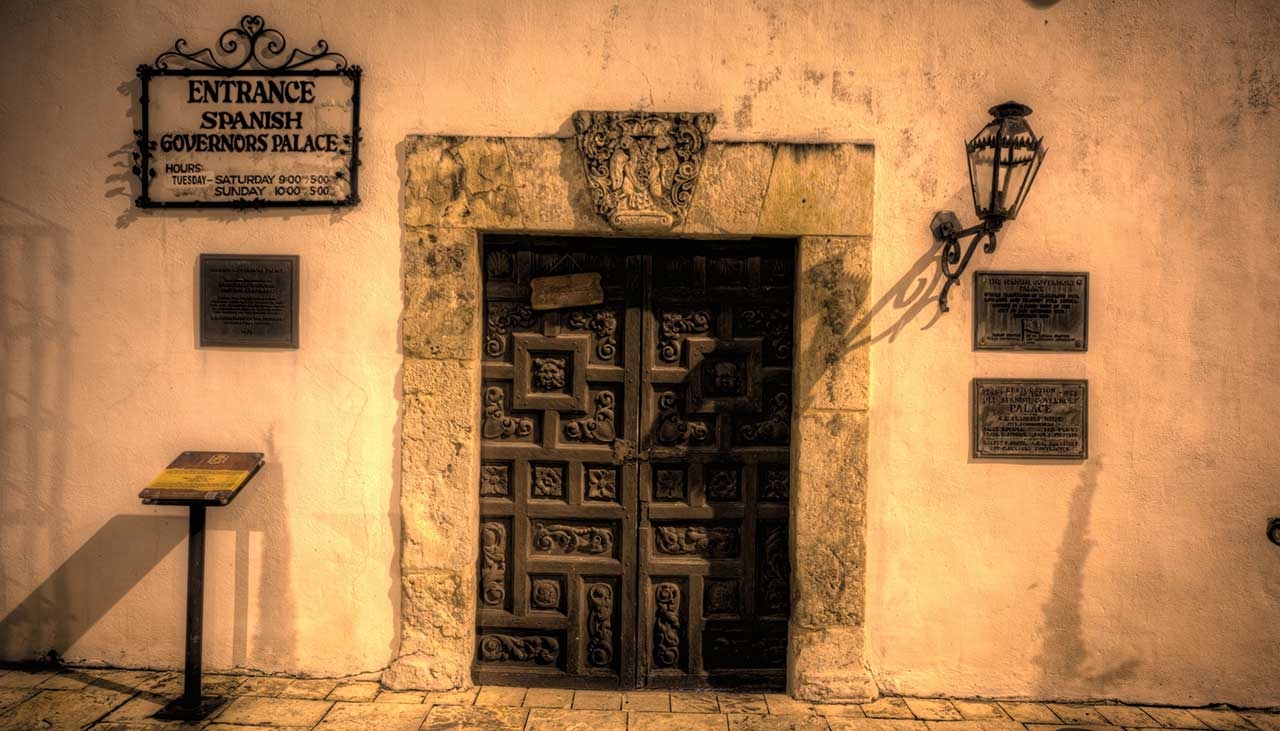
Since the 1930s restoration period, rumors have swirled around about an infant whose bones were buried in the walls of the private chapel. Docia Schultz Williams, in her book, Spirits of San Antonio and South Texas, has argued that that the infant might have been a stillborn within the presidio.
Where questions arise on why the infant was not given a proper burial, Williams reports that it is possible that bad weather caused a delay in bringing the baby to the cemetery. Another theory is that the family might have worried about an attack from the Apache or Comanche peoples while en route to the cemetery to bury the child.
Along the back wall of the private chapel, behind the seventeenth-century chapel of the Virgin Mary, the spot where the infant’s bones were found still remains. Whether the small infant is responsible for any of the paranormal activity at the Spanish Governor’s Palace can’t be said for certain.
As Williams so eloquently put it, “the mystery still goes unsolved."
Another commonly spotted spirit at the Spanish Governor’s Palace is that of a figure most commonly known as the “Lady in Grey.”
It’s believed that she was once a visitor of one of the Spanish Captains, who not only showed up unannounced but also died very mysteriously the night that she arrived at the presidio. Who she was? Your guess is as good as ours, but people have spotted her apparition peeking out of the windows of the Spanish Governor’s Palace at all who wander by.
Stunning in its simplicity, the Spanish Governor’s Palace is one of the most historically important sites to visit while touring San Antonio. At the old presidio you’ll find yourself stepping back in time into Spanish Colonial Texas.
To learn more about the hours of the Museum, and about tours of the interior and the grounds, check out this link.
And if you’re hoping for a more ghostly experience at the Spanish Governor’s Palace, then be sure to check out our San Antonio Ghost Tours.
After all, when the San Antonio Ghost Hunters visited in 2013, they caught shadow people and black mists all about the property.
The Spanish Governor’s Palace might just be one of the most haunted locations in San Antonio—you don’t want to miss out.
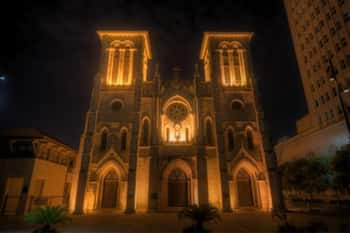
San Antonio's most haunted Church
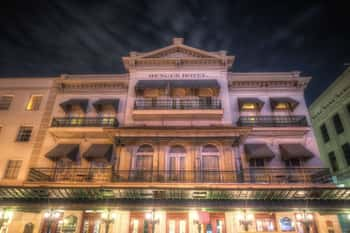
San Antonio's most haunted Hotel

San Antonio's most famous haunted landmark